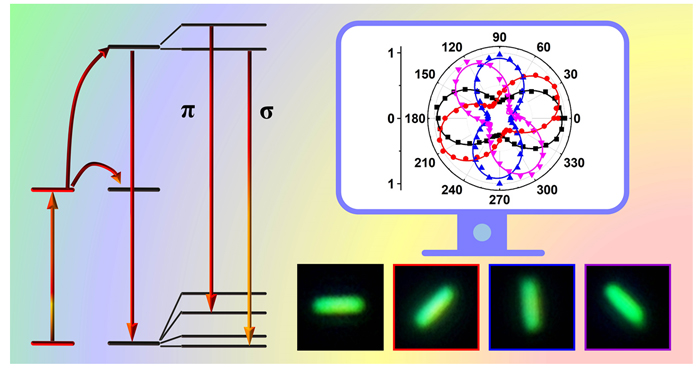| [1] |
Lei, P. P.; An, R.; Yao, S.; Wang, Q. S.; Dong, L. L.; Xu, X.; Du, K. M.; Feng, J.; Zhang, H. J. Adv. Mater. 2017, 29, 1700505.
doi: 10.1002/adma.v29.22
|
| [2] |
Dong, H.; Sun, L. D.; Yan, C. H. J. Am. Chem. Soc. 2021, 143, 20546.
doi: 10.1021/jacs.1c10425
pmid: 34865480
|
| [3] |
Zheng, W.; Huang, P.; Tu, D. T.; Ma, E.; Zhu, H. M.; Chen, X. Y. Chem. Soc. Rev. 2015, 44, 1379.
doi: 10.1039/c4cs00178h
pmid: 25093303
|
| [4] |
Qiu, X. C.; Zhou, Q. W.; Zhu, X. J.; Wu, Z. G.; Feng, W.; Li, F. Y. Nat. Commun. 2020, 11, 4.
doi: 10.1038/s41467-019-13796-w
|
| [5] |
Yang, D. D.; Peng, Z. X.; Zhan, Q. Q.; Huang, X. J.; Peng, X. Y.; Guo, X.; Dong, G. P.; Qiu, J. R. Small 2019, 15, 1904298.
doi: 10.1002/smll.v15.43
|
| [6] |
Yang, D. D.; Peng, Z. X.; Guo, X.; Qiao, S. Q.; Zhao, P.; Zhan, Q. Q.; Qiu, J. R.; Yang, Z. M.; Dong, G. P. Adv. Opt. Mater. 2021, 9, 2100044.
doi: 10.1002/adom.v9.13
|
| [7] |
Wang, F. Y.; Han, Y. M.; Wang, S. M.; Ye, Z. J.; Wei, L.; Xiao, L. H. Anal. Chem. 2019, 91, 11856.
doi: 10.1021/acs.analchem.9b02599
|
| [8] |
Li, X.; Wei, L.; Pan, L. L.; Yi, Z. Y.; Wang, X.; Ye, Z. J.; Xiao, L. H.; Li, H. W.; Wang, J. F. Anal. Chem. 2018, 90, 4807.
doi: 10.1021/acs.analchem.8b00251
|
| [9] |
Zhanghao, K.; Gao, J. T.; Jin, D. Y.; Zhang, X. D.; Xi, P. J. Innov. Opt. Heal. Sci. 2018, 11, 1730002.
|
| [10] |
Zhanghao, K.; Chen, L.; Yang, X. S.; Wang, M. Y.; Jing, Z. L.; Han, H. B.; Zhang, M. Q.; Jin, D. Y.; Gao, J. T.; Xi, P. Light Sci. Appl. 2016, 5, e16166.
doi: 10.1038/lsa.2016.166
|
| [11] |
Zhanghao, K. R.; Chen, X. Y.; Liu, W. H.; Li, M. Q.; Liu, Y. Q.; Wang, Y. M.; Luo, S.; Wang, X.; Shan, C. Y.; Xie, H.; Gao, J. T.; Chen, X. W.; Jin, D. Y.; Li, X. D.; Zhang, Y.; Dai, Q. H.; Xi, P. Nat. Commun. 2019, 10, 4694.
doi: 10.1038/s41467-019-12681-w
pmid: 31619676
|
| [12] |
Zhanghao, K.; Liu, W. H.; Li, M. Q.; Wu, Z. H.; Wang, X.; Chen, X. Y.; Shan, C. Y.; Wang, H. Q.; Chen, X. W.; Dai, Q. H.; Xi, P.; Jin, D. Y. Nat. Commun. 2020, 11, 5890.
doi: 10.1038/s41467-020-19747-0
pmid: 33208737
|
| [13] |
Cruz, C. A. V.; Shaban, H. A.; Kress, A.; Bertaux, N.; Monneret, S.; Mavrakis, M.; Savatier, J.; Brasselet, S. Proc. Natl. Acad. Sci. U. S. A. 2016, 113, E820.
|
| [14] |
Jin, D. Y.; Xi, P.; Wang, B. M.; Zhang, L.; Enderlein, J.; van Oijen, A. M. Nat. Methods 2018, 15, 415.
doi: 10.1038/s41592-018-0012-4
|
| [15] |
Liu, X.; Chen, H. M.; Wang, Y. T.; Si, Y. G.; Zhang, H. X.; Li, X. M.; Zhang, Z. C.; Yan, B. A.; Jiang, S.; Wang, F.; Weng, S. J.; Xu, W. D.; Zhao, D. Y.; Zhang, J. Y.; Zhang, F. Nat. Commun. 2021, 12, 5662.
doi: 10.1038/s41467-021-25993-7
|
| [16] |
Zheng, K. Z.; Loh, K. Y.; Wang, Y.; Chen, Q. S.; Fan, J. Y.; Jung, T.; Nam, S. H.; Suh, Y. D.; Liu, X. G. Nano Today 2019, 29, 100797.
doi: 10.1016/j.nantod.2019.100797
|
| [17] |
Huang, J.; Li, Z.; Liu, Z. H. Acta Chim. Sinica 2021, 79, 1049. (in Chinese)
doi: 10.6023/A21050194
|
|
(黄菊, 李贞, 刘志洪, 化学学报, 2021, 79, 1049).
doi: 10.6023/A21050194
|
| [18] |
Wang, P. P.; Liang, T.; Zuo, M. M.; Li, Z.; Liu, Z. H. Acta Chim. Sinica 2020, 78, 797. (in Chinese)
doi: 10.6023/A20050146
|
|
(王培培, 梁涛, 左苗苗, 李贞, 刘志洪, 化学学报, 2020, 78, 797.)
doi: 10.6023/A20050146
|
| [19] |
Panov, N.; Lu, D. S.; Ortiz-Rivero, E.; Rodrigues, E. M.; Haro-Gonzalez, P.; Jaque, D.; Hemmer, E. Adv. Opt. Mater. 2021, 9, 2100101.
doi: 10.1002/adom.v9.12
|
| [20] |
Lyu, Z. Y.; Dong, H.; Yang, X. F.; Sun, L. D.; Yan, C. H. J. Phys. Chem. Lett. 2021, 12, 11288.
doi: 10.1021/acs.jpclett.1c03409
|
| [21] |
Rodriguez-Sevilla, P.; Zhang, Y. H.; de Sousa, N.; Marques, M. I.; Sanz-Rodriguez, F.; Jaque, D.; Liu, X. G.; Haro-Gonzalez, P. Nano Lett. 2016, 16, 8005.
doi: 10.1021/acs.nanolett.6b04583
|
| [22] |
Chen, P.; Song, M.; Wu, E.; Wu, B. T.; Zhou, J. J.; Zeng, H. P.; Liu, X. F.; Qiu, J. R. Nanoscale 2015, 7, 6462.
doi: 10.1039/C5NR00289C
|
| [23] |
Zhou, J. J.; Chen, G. X.; Wu, E.; Bi, G.; Wu, B. T.; Teng, Y.; Zhou, S. F.; Qiu, J. R. Nano Lett. 2013, 13, 2241.
doi: 10.1021/nl400807m
|
| [24] |
Shi, S.; Sun, L. D.; Xue, Y. X.; Dong, H.; Wu, K.; Guo, S. C.; Wu, B. T.; Yan, C. H. Nano Lett. 2018, 18, 2964.
doi: 10.1021/acs.nanolett.8b00396
|
| [25] |
He, H. L.; Liu, J. X.; Li, K.; Yin, Z.; Wang, J. W.; Luo, D.; Liu, Y. J. Nano Lett. 2020, 20, 4204.
doi: 10.1021/acs.nanolett.0c00601
|
| [26] |
Wei, S. Q.; Shang, X. Y.; Huang, P.; Zheng, W.; Ma, E.; Xu, J.; Zhang, M. R.; Tu, D. T.; Chen, X. Y. Sci. China Mater. 2022, 65, 220.
doi: 10.1007/s40843-021-1713-x
|
 ), 郑伟a,b, 陈学元a,b,*(
), 郑伟a,b, 陈学元a,b,*( )
)
 ), Wei Zhenga,b, Xueyuan Chena,b(
), Wei Zhenga,b, Xueyuan Chena,b( )
)
